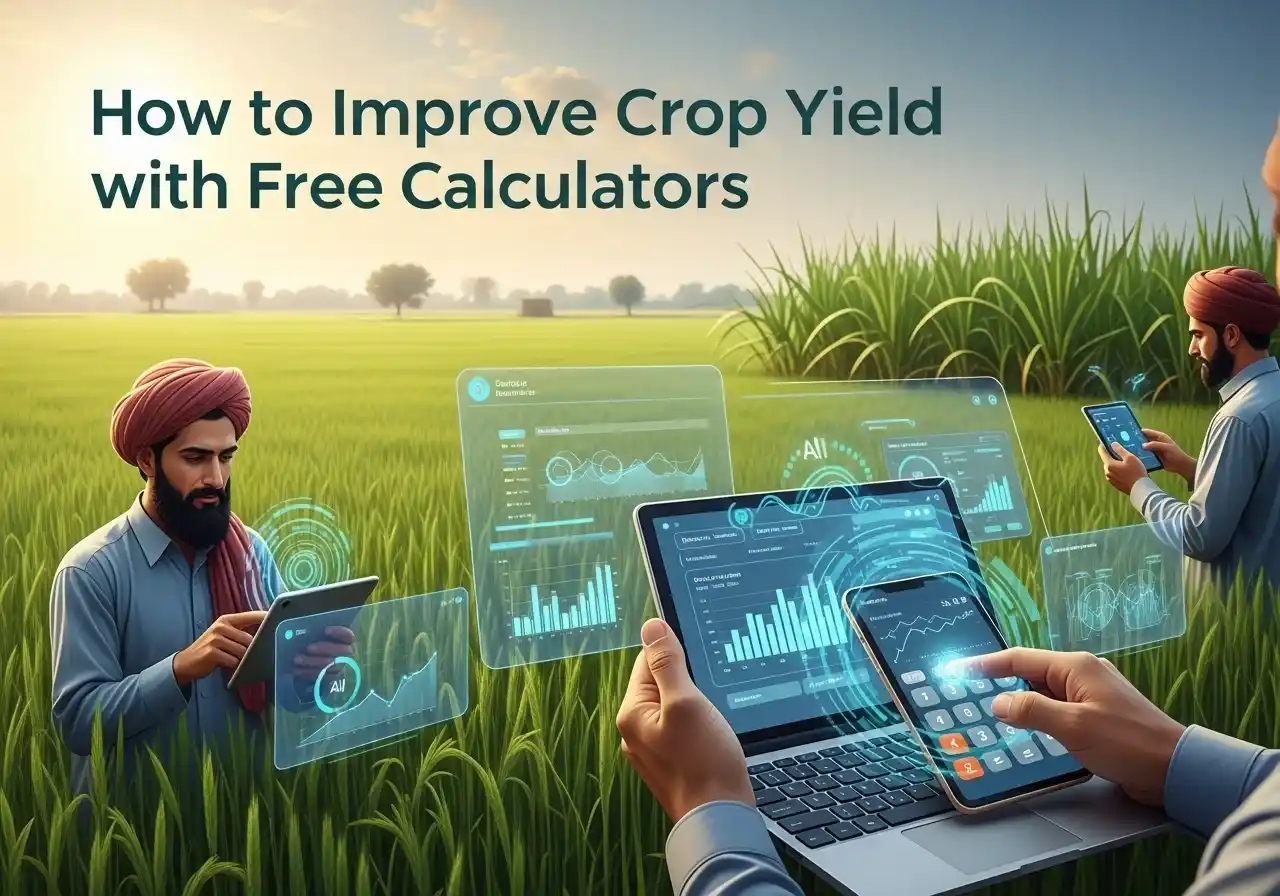Improving crop yield is one of the top priorities for modern farmers, especially in countries like Pakistan, where agriculture supports nearly 40% of the workforce. With the right tools, farmers can predict, plan, and optimize their production. One of the most effective tools for this is the crop yield estimation calculator—a free online tool designed to simplify decision-making and improve efficiency.
Why Crop Yield Estimation Matters
Quick Answer: Knowing your potential crop yield helps in resource optimization, better planning, and sustainable growth.
Estimating yield isn’t just about counting grains or weighing harvests—it’s about predicting performance based on soil, weather, and crop type. Accurate estimation lets farmers:
-
Plan irrigation and fertilizer schedules effectively
-
Avoid waste of seeds and chemicals
-
Forecast market needs
-
Balance profit margins
According to FAO, global crop yield could increase by 20–25% with data-driven farming tools. This highlights how digital agriculture is shaping sustainable food systems.
How Free Calculators Can Help Farmers
Quick Answer: Free online calculators simplify complex farming data into actionable insights.
Farmers no longer need expensive software or consultants. Platforms like free online calculators for everyday use provide simple, accurate tools that handle agricultural, business, and financial needs alike.
For example, a farmer in Punjab or Sindh can use:
-
Crop yield calculators to estimate tons per hectare
-
Fertilizer calculators for nutrient planning
-
Cost calculators to assess profit margins
These tools improve data literacy and decision-making among rural communities, promoting digital transformation in agriculture.
The Role of Technology in Modern Agriculture
Quick Answer: Technology boosts efficiency, minimizes losses, and improves sustainability.
From drones to IoT soil sensors, technology is transforming the agricultural sector. In Pakistan, startups and IT parks—like those supported under Vision 2025—are investing in AgriTech innovations. Farmers are adopting precision agriculture tools that integrate with calculators to make real-time yield assessments.
Expert Quote:
“Digital agriculture is no longer optional—it’s essential for survival in competitive markets,” says Dr. Ahmad Raza, Senior Researcher at the National Agricultural Research Centre (NARC), Islamabad.
Factors That Influence Crop Yield
Quick Answer: Environmental, biological, and management factors directly affect yield.
Main factors include:
-
Soil health and fertility
-
Rainfall and irrigation consistency
-
Crop rotation and pest control
-
Seed quality and planting time
By tracking these inputs using free tools, farmers can forecast variations before harvest, reducing risks caused by climate uncertainty.
Case Study: Crop Yield Improvement in Punjab
Quick Answer: Smart tools increased wheat yield by over 15% in pilot projects.
In southern Punjab, a project led by the Punjab Information Technology Board (PITB) introduced free online calculators and mobile apps to farmers. Within two years, participating farms saw:
-
15–18% higher wheat yield
-
10% reduction in water usage
-
Increased soil health monitoring
This initiative showcases how digital tools empower rural farmers and contribute to national food security.
Training and Government Support for Farmers
Quick Answer: National programs train farmers in digital agriculture and precision tools.
The Prime Minister’s Youth Program and National AgriTech Initiative encourage young graduates to develop or use agricultural calculators and apps.
These programs bridge the gap between IT professionals and traditional farmers—boosting Pakistan’s position as one of the fastest growing IT company in Pakistan hubs through efforts like Dhanote IT Park.
Such collaborations strengthen rural entrepreneurship and promote data-driven agronomy.
Benefits of Using a Crop Yield Estimation Calculator
Quick Answer: Save time, improve accuracy, and maximize profit margins.
Advantages include:
-
Simplifies yield forecasting
-
Reduces guesswork in farm management
-
Helps with crop insurance and financial planning
-
Integrates with other agricultural tools
Farmers can now make informed decisions without deep technical expertise—bringing smart agriculture within everyone’s reach.
Common Mistakes in Crop Yield Prediction
Quick Answer: Ignoring data inputs leads to unreliable estimates.
Avoid these pitfalls:
-
Skipping soil sampling or weather data
-
Using outdated crop coefficients
-
Estimating yield manually without tools
-
Not adjusting for pest or disease loss
Free calculators ensure consistent, reliable estimates by using scientific formulas and live data integration.
Future of Crop Estimation in Pakistan
Quick Answer: The next decade will merge AI, IoT, and cloud-based tools for precise farming.
Pakistan’s agriculture sector is poised for rapid digital adoption. By 2030, experts predict:
-
40% of farms will use digital calculators or smart sensors
-
AI-driven crop forecasting will become standard
-
Government-led data platforms will support farmers nationwide
This evolution will not only boost productivity but also attract tech startups and investors to the agricultural ecosystem.
Frequently Asked Questions
1. What is a crop yield estimation calculator?
A digital tool that calculates potential harvest quantity based on inputs like crop type, area, and average yield.
2. Is the calculator free to use for farmers?
Yes, the tool is completely free and designed for ease of use by farmers and agricultural professionals.
3. How accurate are these calculators?
They use standardized agricultural formulas, providing up to 90–95% accuracy when input data is correct.
4. Can small-scale farmers benefit from online calculators?
Absolutely. They help smallholders plan efficiently, saving time and improving returns.
5. Are there training programs for digital farming tools in Pakistan?
Yes, initiatives like PITB’s e-Agriculture and the National AgriTech Program regularly host training workshops.
6. What crops can be estimated with these calculators?
Common options include wheat, rice, maize, cotton, and sugarcane.
7. How does digital farming impact sustainability?
It reduces waste, optimizes water use, and ensures better soil conservation.
Final Thought
As someone passionate about digital transformation in agriculture, I’ve witnessed how technology empowers farmers in regions like Punjab and Sindh. Tools like the crop yield estimation calculator don’t just improve efficiency—they symbolize the future of smart farming in developing nations.
With continued support from Pakistan’s IT sector, especially through innovation hubs like Dhanote IT Park, agriculture can evolve into a sustainable, data-driven industry that uplifts rural communities and strengthens the nation’s economy.







